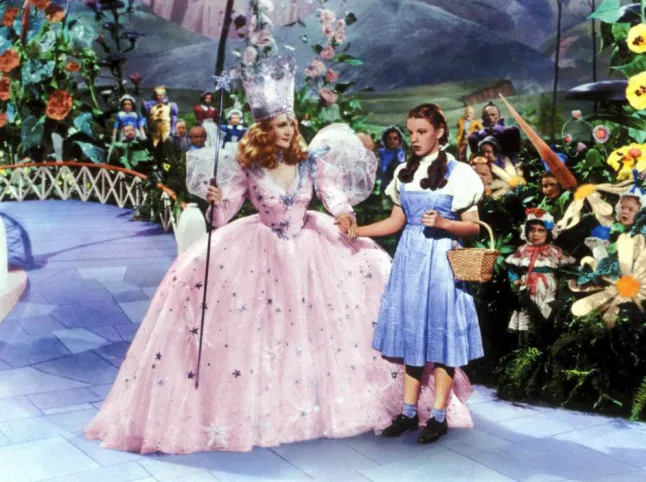The Wizard of Oz (1939)

Picture: Everett/REX Shutterstock
“Follow the Yellow Brick Road,” and you will reach the wizard of mode. From the whimsical ensemble of Munchkinland to the cutting-edge glamour of the shiny Emerald City, Victor Fleming’s 1939 musical film The Wizard of Oz showcases a style utopia filled with exploding colours, nouveau feminine composition, and an impressive amount of pzazz.
No, it’s not all due to the great and powerful Oz but the marvellous costume designer Adrian Adolph Greenburg. As magical as the technicolour movie is with its props and sets, Greenburg had a more elevated understanding of sisterly witchcraft and being over the rainbow. You may not know where you are or where to go, but you must know what to wear.
After the black-and-white beginning of the film, the first iridescent scene we encounter sets the whole mood. As Dorothy Gale exclaims, “Toto, I don’t think we’re in Kansas anymore,” the Land of Oz is not the only new element our eyes must adapt to—Dorothy’s gingham dress is also a striking change. You might ask, what makes a simple dress so powerful? The costume is layered into two pieces: a blue and white checked pinafore and an off-white princess-sleeved blouse with tiny bows on the bodice.
Besides the fashionable technicalities, the dress highlights Dorothy’s young age and where she comes from. After all, she’s a human girl stuck in a supernatural terra firma filled with talking scarecrows, flying monkeys, and an unexpected system of disparity.
Dorothy’s iconic gingham dress, a charming piece of cinematic history, and her enchanting ruby slippers, a dazzling symbol of magic and adventure in fashion lore, are still remembered and admired after nearly 90 years. The slippers, snatched from the Wicked Witch of the East, stole the spotlight and became unforgettable symbols of magic and adventure. Yet, they weren’t always the shiny red we know today.
The original book by L. Frank Baum described Dorothy’s famous slippers as silver. If Baum had the opportunity to see his book adapted into a movie, he would have understood the changes made to it. Metro-Goldwyn-Mayer (MGM) Studios aimed to capitalise on the vibrant visuals, which led screenwriter Noel Langley to propose a change in colour for the adaptation.
With approximately 2,300 sequins, the ruby slippers are considered a cinematic treasure. “There’s no place like home” gains a new meaning, for the motion picture creates a harmonious armistice between Old Hollywood glamour and futuristic mélange.
One of Adrian’s most significant triumphs in costume design is evident in the paradox of dressing Glinda The Good and Wicked Witch of the West, later named Elphaba by “Wicked” novelist Gregory Maguire. Glinda and the Wicked Witch embody contrasting characters, and the costume designer must reflect both witches’ distinct personalities, abilities, and characteristics through fabric and shape.
The pink extravaganza is a perfect example. With a pop of a bubble, we encounter popularity in its most fashionable form. A full-length rose-coloured gown with ruffle stitching and many accessories like a lavish crown encrusted with jewels and a star wand ready to conjure dreams and inspire wonder.
On the other hand, we find a world of green storms swirling with energy and a pointy witch hat perched mischievously atop a similarly wicked head. Representing witches everywhere, Elphaba wears a black, half-ripped dress highlighting her green skin.
Adrian drew inspiration from natural elements, incorporating mushroom textures into the corset’s textile and structure. Glinda’s famous quote, ‘Only bad witches are ugly,’ conversely reminds us that true beauty shines through in brilliance and creativity, just like Greenburg’s timeless work.
What about Dorothy’s companions? The costume design for the Scarecrow, Tin Man, and Cowardly Lion presents a more complex and, I would argue, fascinating challenge. While dressing normal-looking witches is one thing, bringing life to characters and creatures that don’t talk or act is quite another.
Greenburg’s styling for fantasy-based personas makes the movie what it is today. As costumes made from straw, aluminium dust, and fur catch the light, the audience understands how personal and meticulous the design process is, revealing an entirely different world, not over the rainbow but between seams and stitches.
By Leyla Kaptanoglu, a student on the BA Magazine Journalism & Publishing course at London College of Communication

